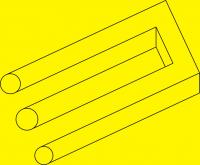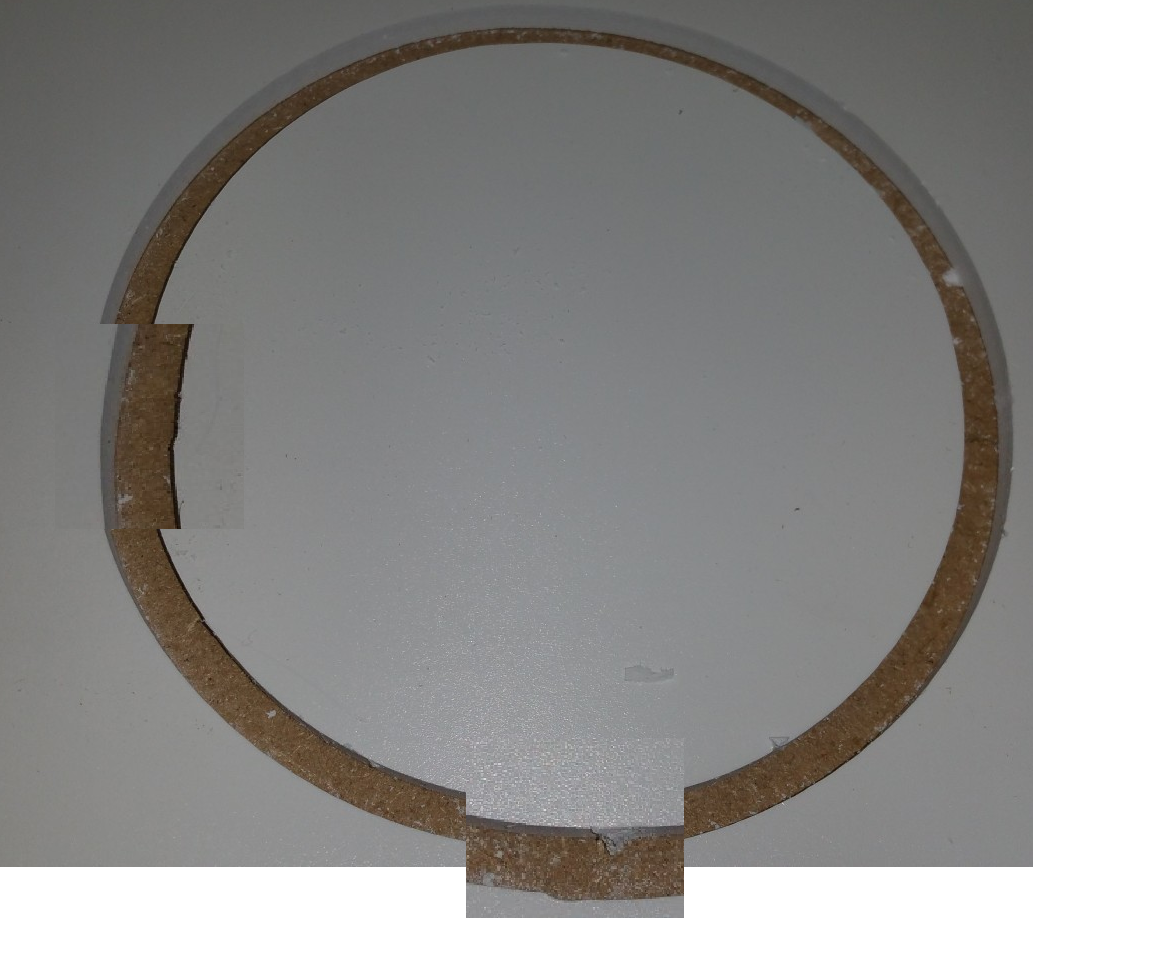problems cutting round holes
- Clifford
- Offline
- New Member
-

Less
More
- Posts: 3
- Thank you received: 0
15 Mar 2016 19:08 #71693
by Clifford
problems cutting round holes was created by Clifford
I recently had a new cnc router installed at work run on linuxcnc.
The machine seems to run well except for cutting circles, for some reason it will not make round holes unless a bit is used that is the same size as the hole to be cut. I have been trying to resolve problems with the manufacturer, but that seems to be a dead end.
the square profile of the part cuts perfectly, but the round cuts do not stay round.
has anyone experienced similar issues with circles not cutting round, but ending up sort of blob shaped?
The machine seems to run well except for cutting circles, for some reason it will not make round holes unless a bit is used that is the same size as the hole to be cut. I have been trying to resolve problems with the manufacturer, but that seems to be a dead end.
the square profile of the part cuts perfectly, but the round cuts do not stay round.
has anyone experienced similar issues with circles not cutting round, but ending up sort of blob shaped?
Please Log in or Create an account to join the conversation.
- Todd Zuercher
-

- Away
- Platinum Member
-

Less
More
- Posts: 4688
- Thank you received: 1433
16 Mar 2016 13:18 #71711
by Todd Zuercher
Replied by Todd Zuercher on topic problems cutting round holes
There are numerous reasons why a part may not cut out right, mechanical problems and software configuration problems and coding errors, can all cause distortions from what you want. We will probably need a lot more information to properly diagnose your problems.
So this is a brand new machine, or a retrofit? What does your problem G-code look like? Does the machine have any mechanical deficiencies (too much backlash or lack of adequate stiffness)?
If this is a new machine in perfect working order, the first place I would look closely at is your G-code. What are your G64 settings?
So this is a brand new machine, or a retrofit? What does your problem G-code look like? Does the machine have any mechanical deficiencies (too much backlash or lack of adequate stiffness)?
If this is a new machine in perfect working order, the first place I would look closely at is your G-code. What are your G64 settings?
The following user(s) said Thank You: Clifford
Please Log in or Create an account to join the conversation.
- Clifford
- Offline
- New Member
-

Less
More
- Posts: 3
- Thank you received: 0
16 Mar 2016 13:31 #71712
by Clifford
Replied by Clifford on topic problems cutting round holes
I have been using code generated by vcarve pro. The machine is new, and seems solid. I am attaching a copy of the gcode for the test and some photos of the failed cuts. I suspect a gcode or software problem since we had similar problems with a machine we replaced with this one and the only common features are the computer that runs the machine with linuxcnc, and vcarve.
Please Log in or Create an account to join the conversation.
- Todd Zuercher
-

- Away
- Platinum Member
-

Less
More
- Posts: 4688
- Thank you received: 1433
16 Mar 2016 14:10 - 16 Mar 2016 14:14 #71715
by Todd Zuercher
Replied by Todd Zuercher on topic problems cutting round holes
What material are you milling? How is it fixtured? I've seen marks like that caused by the material moving or flexing under cutting forces.
Backlash is another notorious source for similar marks, especially when cutting circles. Backlash comp can often cover it up on straight line milling, but on a circle the cutting forces can often move the cutter in the opposite direction of the backlash compensation, and when direction reversals occur (such as at the points of the circle) the backlash compensation will cause a bump as it tries to get things back to where it thinks it should be.
Do you know if your machine is using backlash compensation? If a new machine has that much backlash, there is a problem. Setting the backlash compensation to 0 might reduce the distortion by half, but at the cost of distortion showing up more in other places.
I've also seen similar marks made on light machines cutting with cheep router motors, that have too much play in their spindle shaft bearings.
Backlash is another notorious source for similar marks, especially when cutting circles. Backlash comp can often cover it up on straight line milling, but on a circle the cutting forces can often move the cutter in the opposite direction of the backlash compensation, and when direction reversals occur (such as at the points of the circle) the backlash compensation will cause a bump as it tries to get things back to where it thinks it should be.
Do you know if your machine is using backlash compensation? If a new machine has that much backlash, there is a problem. Setting the backlash compensation to 0 might reduce the distortion by half, but at the cost of distortion showing up more in other places.
I've also seen similar marks made on light machines cutting with cheep router motors, that have too much play in their spindle shaft bearings.
Last edit: 16 Mar 2016 14:14 by Todd Zuercher.
The following user(s) said Thank You: Clifford
Please Log in or Create an account to join the conversation.
- Clifford
- Offline
- New Member
-

Less
More
- Posts: 3
- Thank you received: 0
16 Mar 2016 14:36 - 16 Mar 2016 15:14 #71717
by Clifford
Replied by Clifford on topic problems cutting round holes
the material is 1/4": sintra held on a vacuum table.
I will check about backlash compensation, but I was not told anything about that by the installer.
confirmed that there is no backlash compensation entries in the cnc.ini file.
I will check about backlash compensation, but I was not told anything about that by the installer.
confirmed that there is no backlash compensation entries in the cnc.ini file.
Last edit: 16 Mar 2016 15:14 by Clifford. Reason: new information
Please Log in or Create an account to join the conversation.
- Rick G
-

- Offline
- Junior Member
-

Less
More
- Posts: 27
- Thank you received: 114
17 Mar 2016 06:55 #71766
by Rick G
Replied by Rick G on topic problems cutting round holes
As Todd pointed out there are a few things to look at.
The code does not seem to have any G64 settings. A good idea is to have a preamble to set important settings before making a cut.
linuxcnc.org/docs/2.6/html/gcode/gcode.html#sec:G64
Also try making the cut at a slower speed (too slow may burn), or better a lighter cut, if the current code makes one cut at 1/4" deep try 2 cuts at 1/8" deep to put less strain on the machine to see if that is an improvement. There is also climb cut vs conventional cut, try creating the code to run the opposite direction. Also confirm that everything is tight without excess play.
Rick G
The code does not seem to have any G64 settings. A good idea is to have a preamble to set important settings before making a cut.
linuxcnc.org/docs/2.6/html/gcode/gcode.html#sec:G64
Also try making the cut at a slower speed (too slow may burn), or better a lighter cut, if the current code makes one cut at 1/4" deep try 2 cuts at 1/8" deep to put less strain on the machine to see if that is an improvement. There is also climb cut vs conventional cut, try creating the code to run the opposite direction. Also confirm that everything is tight without excess play.
Rick G
Please Log in or Create an account to join the conversation.
- Todd Zuercher
-

- Away
- Platinum Member
-

Less
More
- Posts: 4688
- Thank you received: 1433
17 Mar 2016 13:49 #71793
by Todd Zuercher
He has G64 P.001 set at the end of the second line of code.
Replied by Todd Zuercher on topic problems cutting round holes
The code does not seem to have any G64 settings.
He has G64 P.001 set at the end of the second line of code.
Please Log in or Create an account to join the conversation.
- Rick G
-

- Offline
- Junior Member
-

Less
More
- Posts: 27
- Thank you received: 114
18 Mar 2016 06:50 #71848
by Rick G
Replied by Rick G on topic problems cutting round holes
Yep, there it is.
Rick G
Rick G
Please Log in or Create an account to join the conversation.
- poofjunior
- Offline
- New Member
-

Less
More
- Posts: 7
- Thank you received: 0
30 Mar 2016 03:57 #72362
by poofjunior
Replied by poofjunior on topic problems cutting round holes
Check out these transitiion points:
On a typical gantry, the cutting tool changes direction on either the X or Y axis at the most extreme dimensions of either axis. Based on the divots you've got at those locations, that's a tell-tale sign of backlash.
To be certain, though, if you see a divot at the most negative X direction, you will likely also see a divot at the most positve X direction, and the same goes for Y.
in your *.ini file, you can set BACKLASH = x.xx, where x.xx is decimal number, for each axis. The software will then make a constant offset each time it changes direction.
To measure the backlash, you'll want a test indicator, but if you don't have one, you can still see if backlash is a problem by adding in some small nonzero values and seeing if that improves the geometry of your cuts.
Best!
JoshuaV
On a typical gantry, the cutting tool changes direction on either the X or Y axis at the most extreme dimensions of either axis. Based on the divots you've got at those locations, that's a tell-tale sign of backlash.
To be certain, though, if you see a divot at the most negative X direction, you will likely also see a divot at the most positve X direction, and the same goes for Y.
in your *.ini file, you can set BACKLASH = x.xx, where x.xx is decimal number, for each axis. The software will then make a constant offset each time it changes direction.
To measure the backlash, you'll want a test indicator, but if you don't have one, you can still see if backlash is a problem by adding in some small nonzero values and seeing if that improves the geometry of your cuts.
Best!
JoshuaV
Please Log in or Create an account to join the conversation.
Time to create page: 0.268 seconds

